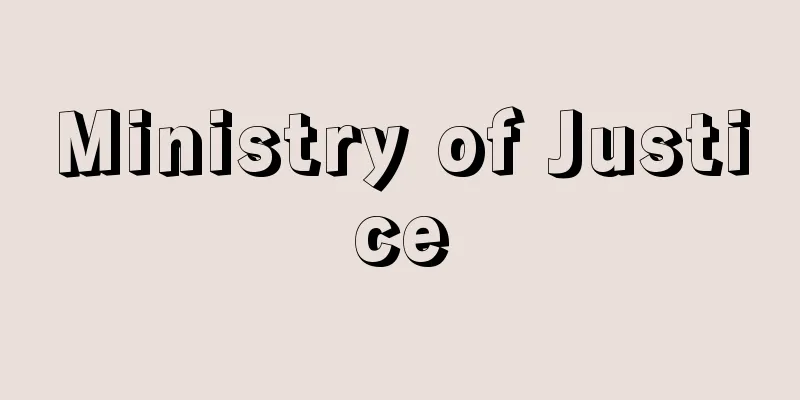Ministry of Justice

|
The Ministry of Justice is a national administrative agency established by the Ministry of Justice Establishment Act, based on Article 3, Paragraph 2 of the National Administrative Organization Act. Its mission is to "maintain and improve the basic legal system, maintain law and order, protect the rights of the people, handle disputes related to the national interest in a unified and fair manner, and ensure fair control of immigration" (Article 3 of the Ministry of Justice Establishment Act). In order to fulfill this mission, the Ministry performs a wide range of administrative tasks in an integrated manner, including prosecution, criminal justice, amnesty, rehabilitation, litigation related to the national interest, nationality, family register, registration, deposit, protection of human rights, immigration control, refugee recognition, regulation of destructive organizations, regulation of organizations that have committed acts of indiscriminate mass murder, and certification of the operations of private dispute resolution procedures. Its history is as follows: It originated from the Ministry of Justice established in 1871 (Meiji 4), and in 1948 (Showa 23) at the direction of the occupying authorities, it absorbed the affairs of the former Legislative Bureau, and affairs related to the investigation and observation of those who were purged from public office, and affairs related to human rights protection were newly added to its responsibilities, and the Ministry of Justice was launched with the Attorney General as its head. After that, it passed through the Ministry of Justice, and during the administrative organizational reform of 1952, a major reorganization was carried out, with affairs related to legislation being transferred to the Cabinet (the Cabinet Legislation Bureau was established) and affairs related to immigration control being absorbed from the Ministry of Foreign Affairs (the Immigration Services Agency, an external bureau of the Ministry of Foreign Affairs, was abolished), and the Ministry of Justice was newly launched. In 2001 (Heisei 13), due to the reorganization of central government ministries and agencies, the Litigation Bureau and six divisions were abolished, and organizational changes were carried out, such as the reorganization and consolidation of councils. In addition to the Minister's Secretariat, there are six internal bureaus: the Civil Affairs Bureau, the Criminal Affairs Bureau, the Corrections Bureau, the Protection Bureau, the Human Rights Bureau, and the Litigation Bureau, which was established in April 2015, as well as the Judicial and Legislative Affairs Department of the Minister's Secretariat. Councils and other bodies include the Bar Examination Committee, the Prosecutor Qualification Examination Board, the Central Parole Board, the Japan Legal Support Center Evaluation Committee, the Legislative Council, and the Special Appointment Examination Board for Public Prosecutors and Notaries. Facilities and other institutions include prisons, juvenile prisons, detention houses (all penal institutions), juvenile training schools, juvenile classification homes, and women's guidance homes. In addition, there is the Public Prosecutor's Office as a special institution. Regional branch bureaus include the Corrections District, the Regional Parole Board, the Legal Affairs Bureau, the District Legal Affairs Bureau, and the Probation Office. External bureaus include the Public Security Examination Commission, the Public Security Intelligence Agency, and the Immigration Services Agency, which was reorganized and expanded from the Immigration Bureau in April 2019, under which are the Regional Immigration Services Bureaus and Immigration Detention Centers. Under the Constitution of the Empire of Japan, the Ministry of Justice was in charge of the administration of justice in general, but currently, under the guarantee of judicial independence in the Constitution of Japan, the Ministry of Justice has no authority over the courts. The position of the Public Prosecutor's Office within the Ministry of Justice is often an issue. The Minister of Justice can generally direct and supervise prosecutors (Article 14 of the Public Prosecutor's Office Law), but due to the nature of its functions, the Public Prosecutor's Office is considered to have an independent status equivalent to that of the courts. [Kazukazu Hirata January 19, 2016] [References] | | | | | | | | |Source: Shogakukan Encyclopedia Nipponica About Encyclopedia Nipponica Information | Legend |
|
国家行政組織法第3条2項に基づき、法務省設置法によって設置された国の行政機関。「基本法制の維持及び整備、法秩序の維持、国民の権利擁護、国の利害に関係のある争訟の統一的かつ適正な処理並びに出入国の公正な管理を図ることを任務とする」(法務省設置法3条)。同省は、この任務を果たすために、検察、行刑、恩赦、更生保護、国の利害に関係のある訴訟、国籍・戸籍・登記・供託、人権の擁護、出入国の管理・難民の認定、破壊的団体の規制、無差別大量殺人行為を行った団体の規制、民間紛争解決手続の業務の認証に関する事項など、多岐にわたる行政事務を一体的に遂行する。 その沿革は次のようなものである。1871年(明治4)に設置された司法省にその源を発し、1948年(昭和23)に占領軍当局の指示により、従前の法制局の事務を吸収するほか、公職追放者等の調査観察等に関する事務、人権擁護に関する事務が新たにその所掌に属することになり、法務総裁を長として法務庁が発足した。その後、法務府を経て、1952年の行政機構改革の際、大幅な整理の断行により法制に関する事務を内閣に移管し(内閣法制局の設置)、出入国の管理に関する事務を外務省から吸収し(外務省の外局の入国管理庁を廃止)、法務省として新発足した。2001年(平成13)中央省庁等の再編により、訟務局や六つの課が廃止され、審議会の整理統合などの組織改編が行われた。内部部局として、大臣官房のほか、民事局、刑事局、矯正局、保護局、人権擁護局、および2015年4月に設置された訟務局の6局と大臣官房の司法法制部がある。審議会等として、司法試験委員会、検察官適格審査会、中央更生保護審査会、日本司法支援センター評価委員会、法制審議会、検察官・公証人特別任用等審査会が置かれている。施設等機関として、刑務所、少年刑務所、拘置所(以上刑事施設)、少年院、少年鑑別所、婦人補導院がある。また、特別の機関として検察庁がある。地方支分部局として、矯正管区、地方更生保護委員会、法務局および地方法務局、保護観察所がある。外局として、公安審査委員会、公安調査庁、2019年4月に入国管理局を改組・拡充した出入国在留管理庁があり、その下に地方出入国在留管理局および入国者収容所が置かれている。 大日本帝国憲法における司法省は、司法行政全般をつかさどっていたが、現在は日本国憲法における司法権の独立の保障のもとで、法務省は裁判所に対してなんらの権限も有しない。検察庁の法務省における位置づけがしばしば問題となる。法務大臣は、検察官を一般的に指揮監督できるが(検察庁法14条)、検察庁はその機能の性質上、裁判所の独立に準ずるような独立的地位にあるとされる。 [平田和一 2016年1月19日] [参照項目] | | | | | | | | |出典 小学館 日本大百科全書(ニッポニカ)日本大百科全書(ニッポニカ)について 情報 | 凡例 |
<<: Asylum - Refuge (English spelling)
Recommend
Anshin-in [town] - Ajimu
An old town in Usa County, northern Oita Prefectur...
Greenglass, D.
...This incident triggered a search in the United...
Temporary house
〘noun〙① A temporary house. A makeshift house. A re...
mandamus proceeding
...The original government draft of the Local Aut...
Aogashima [Village] - Aogashima
…It is an island located about 70 km south of Hac...
Manucci, T.
…Italian humanist and publisher. His Italian name...
Fadeev, Aleksandr Aleksandrovich
Born: December 24, 1901. Kimrui [Died] May 13, 195...
Kuleshov, LV (English spelling) KuleshovLV
...And so, Pudovkin and Eisenstein created and fo...
Normative part - normative part
In Germany, Article 1 of the Labor Agreements Act...
Emperor's Letter - Shinkanyo
Shinkan refers to the handwriting of the emperor. ...
Antoine Fabre d'Olivet
1767‐1825 French writer and mystic. He was influen...
Aaltonen, W.
… Finnish sculpture and architecture reflect the ...
Rissho Kosei-kai
This is a lay Buddhist sect that worships Shakyam...
Great white-spotted stork - Great white-spotted stork
...The species that breeds in Europe and North Af...
Iceboating
A sailboat on ice, propelled by sails, and a sport...









